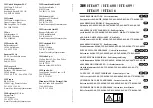
11
6.5
PH Sensor Maintenance
When measuring the pH sensor, it should be cleaned in distilled water (or deionized water), and the filter paper should be used to
absorb moisture to prevent impurities from being introduced into the liquid to be tested. 1/3 of the sensor should be inserted into the
solution to be tested.
The sensor should be washed when not in use, inserted into a protective sleeve with a 3.5 mol/L potassium chloride solution, or the
sensor inserted into a container with a 3.5 mol/L potassium chloride solution.
If the liquid in the cover of the pH sensor dries out, you could replace the liquid with potassium chloride liquid or tap water. Please
do not use purified water or deionized water.
Check if the terminal is dry. If it is stained, wipe it with absolute alcohol and dry it. Avoid long-term immersion in distilled water or
protein solution and prevent contact with silicone grease. With a longer sensor, its glass film may become translucent or with
deposits, which can be washed with dilute hydrochloric acid and rinsed with water. The sensor is used for a long time. When a
measurement error occurs, it must be calibrated with the meter for calibration.
When the calibration and measurement cannot be performed while the sensor is being maintained and maintained in the above
manner, the sensor has failed. Please replace the sensor.
7. Important Maintenance Instruction
Your device is a product of superior design and craftsmanship and should be used with care. The following suggestions will help you use
the warranty service effectively.
• Keep the equipment dry. Rain, moisture, and various liquids or moisture may contain minerals that can corrode electronic circuits. In
case the
device is wet, please dry it completely.
• Do not use or store in dusty or dirty areas. This can damage its detachable parts and electronic components.
• Do not store in excessive heat. High temperatures can shorten the life of electronic devices, destroy batteries, and deform or melt some
plastic parts.
• Do not store in excessive cold place. Otherwise, when the temperature rises to normal temperature, moisture will form inside, which
will
destroy the board.
• Do not throw, knock or shake the device. Rough handling of equipment can destroy internal circuit boards and delicate structures.
• Do not wash with strong chemicals, detergents or strong detergents.
• Do not apply with paint. Smudges can block debris in detachable parts and affect normal operation.
• Do not throw the battery into a fire to prevent the battery from exploding. Damaged batteries may also explode.
All of the above suggestions apply equally to your device, battery and accessories. If any device is not working properly.
Please take it to the nearest authorized service facility for repair.
Summary of Contents for R72608
Page 11: ...10 15...






























